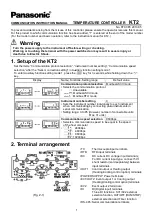
WM Access Domain Services
Summit WM20 User Guide, Software Release 4.2
86
●
Each WM-AD also offers unique Authentication, Authorization and Accounting (AAA) services.
Setting up a WM-AD Checklist
WM-AD provides a versatile means of mapping wireless networks to the topology of an existing wired
network. When you set up a WM-AD on the Summit WM Controller, you are defining a subnet for a
group of wireless device users. The WM-AD definition creates a virtual IP subnet where the Summit
WM Controller acts as a default gateway to wireless devices.
In addition you can determine if the WM-AD is to apply for traffic bridging at the AP. This type of
WM-AD requires specification of RF parameters and authentication parameters (if AAA type), although
filtering specifications and topology specifications do not apply.
The Summit WM Controller WM20 provides the option to define a WM-AD as locally bridged to a
VLAN at the controller. To support that configuration, you must define which VLAN the WM-AD
should bridge to. With this configuration, it is possible that the controller is not involved in the IP
address assignment for user addresses. Instead, the IP addresses for users are assigned directly by the
DHCP infrastructure that services the VLAN.
NOTE
In a VLAN-bridged WM-AD, the default configuration dictates that the controller is not the DHCP server for that
segment. However, DHCP services can selectively be enabled, including DHCP Relay, allowing you to use the
controller to become the default DHCP server for the VLAN, if applicable.
Before defining a WM-AD, the following properties must be determined:
●
A user access plan for both individual users and user groups
●
The RADIUS attribute values that support the user access plan
●
The location and identity of the Wireless APs that will be used on the WM-AD
●
The routing mechanism to be used on the WM-AD
●
For tunneled configurations mostly, the network addresses that the WM-AD will use
●
A VLAN bridged WM-AD (at the controller) requires the specification of the IP address for the
controller's own interface point (Port) on that VLAN. In addition, if the you elect to have the
controller operate as the default DHCP server for the VLAN, the corresponding IP topology for that
subnet must also be specified.
●
The type of authentication for wireless device users on the WM-AD
●
The specific filters to be applied to the defined users and user groups to control network access
●
The quality of service (QoS) requirements
●
What privacy mechanisms should be employed between the Wireless APs and the wireless devices
●
Classification list for traffic priority. For example, whether the WM-AD is to be used for voice traffic
and if voice traffic is to be given priority.
●
Whether the WM-AD traffic is to be bridged directly to the network at the AP or tunneled to the
controller for forwarding. Bridging at the AP is useful in branch office deployments in which APs
must provide service even when the connection to the controller is unavailable.
Содержание Summit WM20
Страница 8: ...Table of Contents Summit WM20 User Guide Software Release 4 2 8 ...
Страница 20: ...About this Guide Summit WM20 User Guide Software Release 4 2 20 ...
Страница 54: ...Configuring the Summit WM Controller Summit WM20 User Guide Software Release 4 2 54 ...
Страница 96: ...WM Access Domain Services Summit WM20 User Guide Software Release 4 2 96 ...
Страница 150: ...WM Access Domain Services Configuration Summit WM20 User Guide Software Release 4 2 150 ...
Страница 168: ...Availability and Controller Functionality Summit WM20 User Guide Software Release 4 2 168 ...
Страница 172: ...Working With Third Party APs Summit WM20 User Guide Software Release 4 2 172 ...
Страница 184: ...Working With the Summit WM Series Spy Summit WM20 User Guide Software Release 4 2 184 ...
Страница 194: ...Working With Reports and Displays Summit WM20 User Guide Software Release 4 2 194 ...
Страница 216: ...Performing System Maintenance Summit WM20 User Guide Software Release 4 2 216 ...
















































